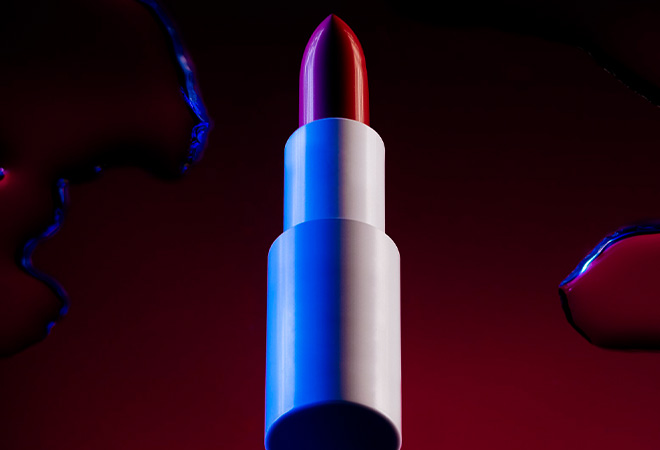
What were the unique factors that made red lipstick become what it is? Why didn’t we have a similar thing evolve around mascara, eyeliner, or any other kind of cosmetic product?
Initially red was easiest to make, the dyes were readily available, and so for years that was the color. For generations, we didn’t think of lipstick as self-expression; this is my shade, I’m a pink person or a nude person. Initially it was about recapturing that youthful flush. Up until the second half of the 20th century, it was less about standing out and more about fitting. There was a lot of social pressure in the advertising.
Red lipstick serves a lot of functions. One, it was easy to make, from ground-up beetle bodies. Two, it was what everyone was wearing. And it’s such a statement, wonderfully unnatural in the best possible way. It has all these iconic moments. It’s interesting if you look at the early ‘60s; the counterculture, like the fashion culture, completely rejects the red lip. They go the direction of this practically white, very pale pink. That was about rejecting the conformity and tradition of it.
There is a film critic I studied with, Molly Haskell, who says you wear the opposite of whatever your mother wore: your mother was from a natural or pink generation, you wear red, and vice versa. Red is such a sexy, bold color, it has become so fetishized. It’s become the power color.
The hot shade in the ‘90s was a darker, or just insanely red, lip, but then you’ll see more sedate ‘50s reds, sheer reds, glitter reds, more orangey reds. It’ll change but stay in that family. I have read almost 300 years of beauty press now—every few years without fail someone says the red lip is back. And we shouldn’t do that because it never goes away.
What contexts, trends, or developments will be most relevant in the near future?
Americans don’t respond well to any kind of deprivation, and often respond to scarcity or inability to wear lipstick with a huge, bold consumption of it. The year and a half of wearing a mask and the coming out of a nude lip trend, I feel like people won’t want anything subtle. A bright color is going to be the next thing that we’re going to start getting back, away from that overinflated, nude, Instagram influencer lip. I hope that people are going to start discovering what suits them rather than the trends. That’s my guess: red, pink, and purple lips are going to make a comeback.
This idea of the lipstick effect has come up recently, but obviously with the mask covering you aren’t going to buy a lipstick, even if it is an uplifting thing.
I’m not a believer in the lipstick effect. I’ll tell you why: because it doesn’t work out mathematically. Women buy lipstick in good times, women buy lipstick in bad times. The logic behind it is real, it’s credited to [Leonard] Lauder but it actually goes back to the 1930s, the Depression. I spent about two years working for Wall Street firms, so I have some sense of how to read financial analysis, and it’s not a good indicator. It sounds right, but there’s no attachment there for it to be an actual economic indicator. But with the not buying lipstick for a year and a half, the industry is probably leaning upturn.
Something else you touched upon is gender as a construct. How will evolving ideas around fluid gender concepts influence how we view lipstick?
Drag is probably five minutes older than gender norms. I am old enough to remember Boy George and Adam Ant and when that was a big deal. Lipstick comes and goes for straight cis het men, but it’s exciting to see a new generation be more open to the idea, and that it wasn’t necessarily just for one small corner of the world. I recently did a lecture on lipstick and subversion. I was looking around and there are now huge [male representing] K-pop stars who are wearing a gloss. It’s cool to see that even more mainstream brands like L’Oréal believe now that not every model is a white woman. There’s so far to go, but seeing change start to come in, even if for some of the companies it is mercenary or about their bottom line, is still generally, very good. Huge companies like MAC are responding to feedback from their own employees and changing their slogan to All Ages, All Races, All Genders because that was more reflective and inclusive of what they’re actually talking about. It’s really interesting to see people adjust to that change in the market and culture.
What are your predictions for the rebound effect of being able to wear lipstick again? Are there any other evolving cultural roles for lipstick?
I was in a meeting yesterday with one of my clients, and they’re talking about trying to do online live selling now, this very immediate form. With the influencer culture and how busy the market is, people are really filing down their message to a very fine point. That is going to continue. Makeup used to be drugstore makeup and department store makeup, which was either more modern like Clinique, or classic continental like Lancôme. It didn’t get much finer than that. Now, people really want to see themselves in the company, whether that means more companies fronted by people of color, more companies that are sustainable, more companies that are socially active. That is really driving what the market looks like. Rihanna really pioneered that with Fenty Beauty—she’s the one to beat in terms of connecting with an audience, in terms of recognizing who your customer is, and how you speak to them in their language rather than having them come to you.
There was also a debate around nude lipstick, and how often that was associated with a fair skin tone. Nude didn’t acknowledge all the other skin tone spectrums.
That’s a question of not just going through your customer, but who’s sitting at the table through “Not everyone who buys our lipstick looks like us.” It should be representation, not just in the market, but in the boardroom, design and development phase. Nude doesn’t necessarily mean light pink or beige. And there is so much to be done in terms of who is sitting at the board table. I could not get over how few women sit at the head of boards. Even when you talk about it historically, yes there were Estée Lauders and Helena Rubensteins, but also Max Factor and Charles Revson who had founded Revlon. So many guys who were not that interested in female input. They’re like, “I’ll tell you what you like,” it was very much one of those old types of businessmen. Who is sitting at the table is going to make a huge difference going forward.








